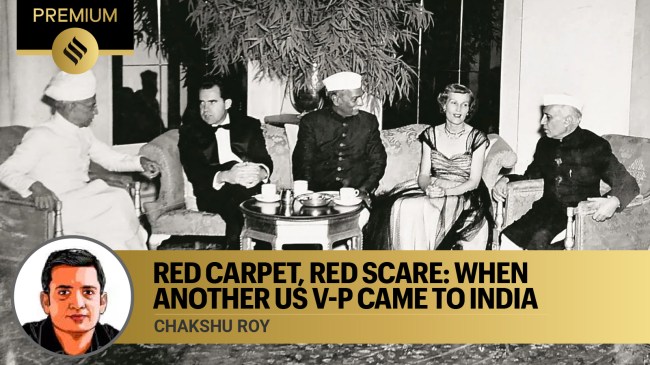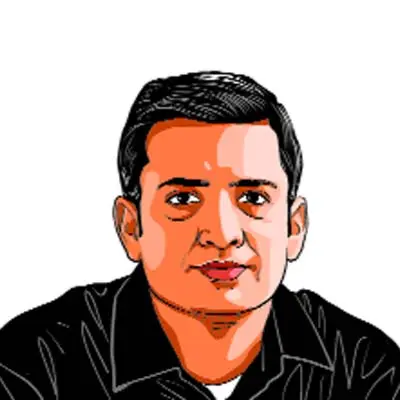Opinion Red carpet, red scare: When another US V-P came to India
The first US V-P to visit India was another 40-year-old, Richard Nixon. In 1953, Republican candidate Dwight D Eisenhower became the US President, and his running mate, Nixon, became the V-P. In the US system, the V-P is the Senate’s presiding officer and, other than that, only holds a ceremonial position.
 (From left) Vice-President S Radhakrishnan, US Vice-President Richard Nixon, President Rajendra Prasad, Nixon’s wife Pat and Prime Minister Jawaharlal Nehru at Rashtrapati Bhavan in 1953. (X/@RBArchive)
(From left) Vice-President S Radhakrishnan, US Vice-President Richard Nixon, President Rajendra Prasad, Nixon’s wife Pat and Prime Minister Jawaharlal Nehru at Rashtrapati Bhavan in 1953. (X/@RBArchive) During his just concluded four-day tour of India, US Vice-President (V-P) James David Vance and his family visited the Akshardham temple, met Prime Minister Narendra Modi and visited Jaipur, where the 40-year-old V-P gave a public lecture. The visit ended with a family photograph before the Taj Mahal — and coincided with a terror attack in Pahalgam, J&K.
The first US V-P to visit India was another 40-year-old, Richard Nixon. In 1953, Republican candidate Dwight D Eisenhower became the US President, and his running mate, Nixon, became the V-P. In the US system, the V-P is the Senate’s presiding officer and, other than that, only holds a ceremonial position. However, Eisenhower carved out a greater diplomatic role for Nixon. He gave Nixon the responsibility of spreading the American sphere of influence in Asia and sent him on a two-month, 16-country goodwill tour. As part of this tour, Nixon reached India at the end of November 1953.
The catalyst for his visit was the US government’s apprehension of India coming close to Communist powers. A year earlier, the US Ambassador to India sent a top-secret communication to President Harry Truman. He wrote, “Recent Communist successes in South India indicate how rapidly political and economic situation here could disintegrate. Failure of Indian democracy would in all probability result in disaster more substantial than Communist victory in China since Southeast Asia and Middle East would become impossible to hold once India is lost. Communist sweep in Asia would gravely undermine our position in Europe and convince hundreds of millions of our friends all over the world that they are betting on the wrong horse.”
On November 29, 1953, Nixon, his wife Pat and the American delegation flew into Bangalore from Sri Lanka (then Ceylon). The visit took place at a time when there was news that America was planning to supply arms to Pakistan. But despite this sourness, the V-P received a rousing welcome. The American Ambassador described Nixon’s reception as “unprecedented … with most of the city’s populace lining streets and cheering on way from airport”. Travelling in an open-top car, the V-P and his wife stopped at crowded intersections to shake hands with people.

The meatier part of the visit started two days later when Nixon reached Delhi. He engaged with President Rajendra Prasad, Vice-President S Radhakrishnan and Prime Minister Jawaharlal Nehru. Then, there were the classic photo opportunities: The V-P and the second lady interacting with villagers, Nixon using a shovel to dig a ditch and steer a buffalo-driven plough, Pat Nixon making chapatis, visiting an orphanage and finally, a photograph in front of the Taj Mahal.
But the trip’s highlight was when Nixon spoke to Lok Sabha and Rajya Sabha MPs in the Central Hall of the circular Parliament building. Till then, no visiting dignitary had given a speech to MPs, and Nixon was the first. The idea of inviting Nixon to address MPs originated because Prime Minister Nehru had addressed both Houses of the United States Congress during his visit in 1949. Our Parliament had formed an “Indian Parliamentary Group”, and one of its objectives was to arrange lectures from distinguished persons. During Nixon’s visit, Parliament was meeting for its winter session, making it convenient for parliamentarians to hear from the V-P formally.

Nixon’s speech was scheduled in the evening after both Houses had adjourned for the day. In the Central Hall, the Chairman of the Rajya Sabha, Dr S Radhakrishnan, introduced Nixon. During his half-hour speech, Nixon applauded India, saying, “The air you breathe here is free; there is tolerance of religion, freedom of speech, press, justice under law and dedication to the way of peace.” He went on to make three broad points.
First, India would play a decisive role in the future of Asia and the world, and America was interested in seeing India succeed. Second, the US foreign policy was non-aggressive, non-imperialist, non-colonial and non-isolationist. “The USA desires nothing in the world today from any other people or country except their friendship.” And finally, the totalitarian system headed by Communist leaders was the only force that threatened the peace of the world.

The American Ambassador considered the visit a success. In a cable to the State Department, he reported, “The Vice President’s private talks with Indian leaders … have all been frank and cordial. India and US points of difference remain, but I do not believe we could hope for any more beneficial results to be obtained from a single visit.”

Nixon’s Asia goodwill tour mostly went according to plan. However, five years later, in 1958, during Eisenhower and Nixon’s second term, a similar goodwill tour was an unmitigated disaster. This time, Nixon was touring independent Latin American countries. First, there were the occasional Communist protests. Then things escalated in Peru when a protester “let fly a wad of spit”, which landed full on Nixon’s face. In his book Six Crises, Nixon describes the incident and says that he wanted to tear off the spitter’s face, but his security detail stopped him. He had to contend with landing “a healthy kick” on the spitter’s shins. A couple of days later, in Venezuela, hundreds of communist protestors rained spit on the V-P and his entourage.
The writer looks at issues through a legislative lens and works at PRS Legislative Research





